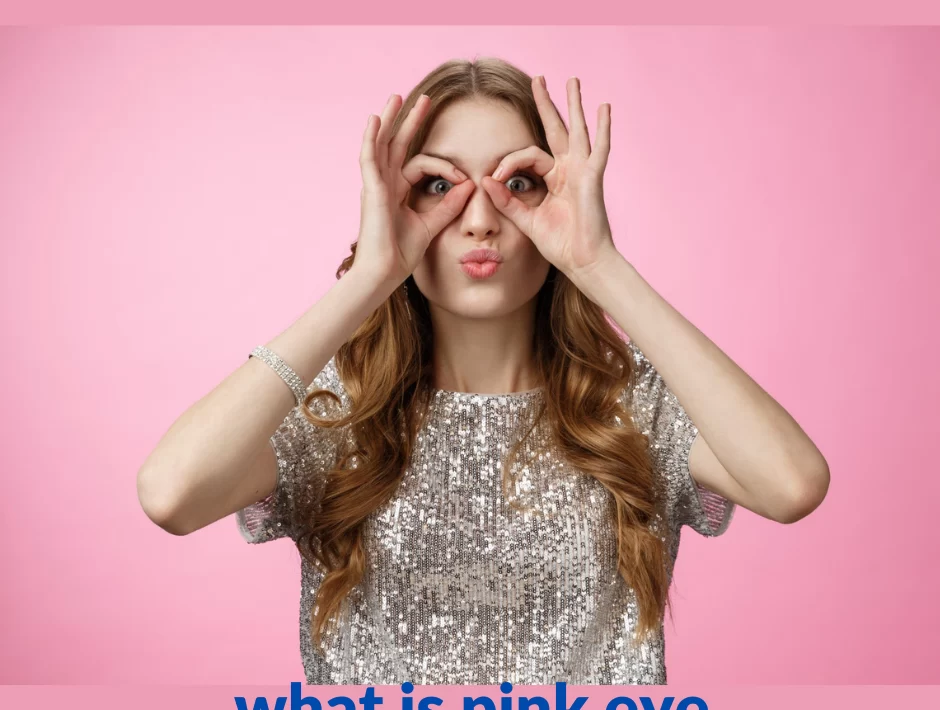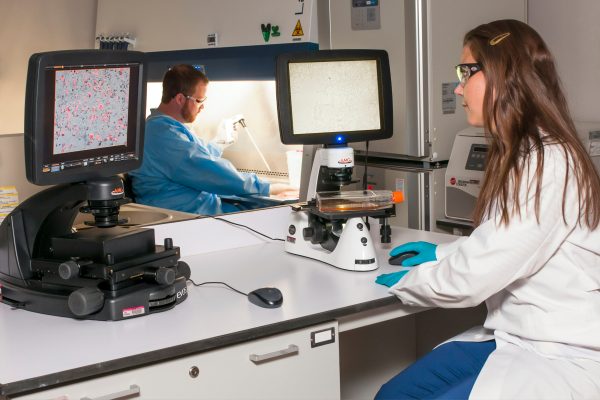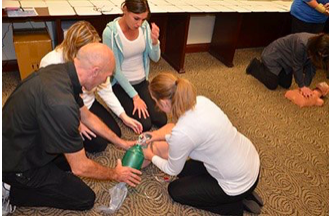Table of Contents
What Is Pink Eye?
Pink eye, medically known as conjunctivitis, is an inflammation of the thin, transparent tissue (conjunctiva) that covers the front surface of the eye and lines the inner surface of the eyelids. It is characterized by symptoms such as redness, itching, tearing, and the presence of discharge from the eye. Pink eye can be caused by viruses, bacteria, allergens, or irritants, and its treatment depends on the underlying cause.
Causes of Pink Eye:
Pink eye, or conjunctivitis, can be caused by various factors, including:
- Viral Infections: Viruses, such as the adenovirus, can lead to viral conjunctivitis. It’s highly contagious and often accompanies common cold symptoms.
- Bacterial Infections: Bacterial conjunctivitis is caused by bacteria like Staphylococcus or Streptococcus. It can result in more discharge and stickiness of the eyelids.
- Allergic Reactions: Allergens like pollen, pet dander, or dust mites can trigger allergic conjunctivitis, leading to redness, itching, and watery eyes.
- Irritants: Exposure to irritants like smoke, chlorine, or chemicals can cause irritant conjunctivitis, resulting in redness, discomfort, and tearing.
- Contact Lenses: Improper use or poor hygiene with contact lenses can lead to conjunctivitis, often due to bacterial or fungal growth on the lenses.
- Newborn Conjunctivitis: Newborns can develop conjunctivitis due to blocked tear ducts, infections acquired during childbirth, or exposure to maternal genital bacteria.
- Sexually Transmitted Infections (STIs): In rare cases, certain STIs like gonorrhea or chlamydia can cause conjunctivitis, typically through direct contact.
- Autoimmune Conditions: Some autoimmune disorders, such as rheumatoid arthritis or lupus, can cause inflammation in the eye, leading to conjunctivitis.
- Chemical Exposure: Exposure to chemicals or foreign substances can result in chemical conjunctivitis, causing redness and irritation.
- Trachoma: This bacterial infection, often found in developing countries with poor sanitation, can lead to severe conjunctivitis and is a leading cause of preventable blindness.
Symptoms and Signs:
Common symptoms and signs include:
- Redness: The white part of the affected eye appears pink or red due to inflammation of the conjunctiva.
- Itching: The eyes may feel itchy or irritated, leading to frequent rubbing.
- Tearing: Excessive tearing or watery eyes can be a result of the inflammation.
- Discharge: Depending on the cause, the eye might produce a clear, watery discharge or a thicker, yellow or greenish discharge that can cause the
eyelids to stick together, especially upon waking up. - Gritty Sensation: The eyes may feel gritty or sandy, contributing to the overall discomfort.
- Swelling: Swelling of the conjunctiva and eyelids can occur, causing a puffy appearance.
- Blurry Vision: Vision can become temporarily blurred due to the inflammation and discharge.
- Crusting: Crusting or matting of the eyelashes, particularly after sleep, can occur due to dried discharge.
- Different Patterns Based on Cause: Different types of conjunctivitis might present with specific patterns. For example, allergic conjunctivitis can
cause intense itching and significant tearing, while bacterial conjunctivitis often leads to thicker discharge and discomfort. - One or Both Eyes: Conjunctivitis can affect one or both eyes, and if it’s contagious, it often spreads from one eye to the other.
- Newborn Symptoms: In newborns, symptoms might include excessive tearing, discharge, and eyelid swelling. Newborn conjunctivitis can have various causes, including blocked tear ducts or infections.
Diagnosis and Medical Evaluation:
Diagnosing pink eye (conjunctivitis) involves a medical evaluation by a healthcare professional, typically an ophthalmologist, optometrist, or primary care physician. The process may include:
- Medical History: The healthcare provider will ask about your symptoms, their duration, any recent exposures to potential irritants or infections, and your overall health.
- Physical Examination: The doctor will examine your eyes, looking for signs of redness, discharge, swelling, and other characteristic symptoms.
- Eye Examination: The healthcare provider will use specialized tools to examine the front of your eyes, including the conjunctiva, cornea, and eyelids.
- Eye Secretion Analysis: If there is discharge, a sample might be taken to determine the cause of the conjunctivitis, especially in cases of suspected bacterial or viral infection.
- Fluorescein Staining: This test involves placing a special dye on the eye’s surface to identify any corneal abrasions or damage.
- Allergy Testing: If allergic conjunctivitis is suspected, allergy testing might be recommended to identify specific allergens triggering the reaction.
- Underlying Conditions: If your healthcare provider suspects an underlying condition like an autoimmune disorder, they might inquire about your medical history and conduct further tests.
- Newborn Evaluation: In cases of neonatal conjunctivitis, special attention is given to newborns to determine the cause and provide appropriate treatment.
- Testing for STIs: If chlamydial or gonococcal conjunctivitis is suspected, appropriate testing for sexually transmitted infections might be done.
The accurate diagnosis of pink eye is crucial, as treatment varies depending on the cause. It’s important to follow the guidance of your healthcare provider, especially if the condition is severe, persistent, or affecting your vision. Self-diagnosis and treatment may lead to improper management and complications.
Types And Treatments Options for Pink Eye:
Here are the different types of pink eye (conjunctivitis) and their corresponding treatment options:
- Viral Conjunctivitis:
- Cause: Caused by viruses, particularly adenoviruses.
- Treatment:
- Typically, viral conjunctivitis resolves on its own within 1-2 weeks.
- Artificial tears or lubricating eye drops can help soothe discomfort and dryness.
- Cold compresses may alleviate swelling and discomfort.
- Practice good hygiene to prevent spreading the virus, such as frequent hand washing and not touching your eyes.
- Bacterial Conjunctivitis:
- Cause: Caused by bacterial infections, often by Staphylococcus or Streptococcus.
- Treatment:
- Antibiotic eye drops or ointments prescribed by a doctor are the main treatment.
- Complete the full course of antibiotics as directed, even if symptoms improve.
- Allergic Conjunctivitis:
- Cause: Triggered by allergens like pollen, pet dander, or dust.
- Treatment:
- Avoid allergen exposure whenever possible.
- Over-the-counter or prescription antihistamine eye drops can help alleviate itching and redness.
- Cold compresses and artificial tears provide relief.
- Irritant Conjunctivitis:
- Cause: Caused by exposure to irritants like smoke, chemicals, or foreign objects.
- Treatment:
- Identify and remove the source of irritation.
- Cold compresses and artificial tears can provide relief.
- Giant Papillary Conjunctivitis:
- Cause: Often linked to prolonged use of contact lenses.
- Treatment:
- Temporarily discontinuing contact lens use.
- Switching to daily disposable lenses or rigid gas-permeable lenses.
- Eye drops to reduce inflammation and itching.
- Neonatal Conjunctivitis:
- Cause: Various causes, including maternal infections during childbirth.
- Treatment:
- Antibiotic eye drops or ointments, as determined by a doctor.
- Chemical Conjunctivitis:
- Cause: Caused by exposure to chemicals or irritants.
- Treatment:
- Immediate flushing of the eyes with clean water for at least 15 minutes.
- Seeking medical attention promptly to prevent further damage.
- Autoimmune Conjunctivitis:
- Cause: Linked to underlying autoimmune disorders.
- Treatment:
- Management of the underlying autoimmune condition with medications.
- Chlamydial or Gonococcal Conjunctivitis:
- Cause: Caused by sexually transmitted infections (STIs).
- Treatment:
- Systemic antibiotics prescribed by a healthcare provider.
- Fungal Conjunctivitis:
- Cause: Caused by fungal infections (rare).
- Treatment:
- Antifungal medications prescribed by a doctor.
- Trachoma:
- Cause: Caused by the bacterium Chlamydia trachomatis.
- Treatment:
- Antibiotics to treat the infection.
- In advanced cases, surgery might be necessary to prevent vision loss.
Preventive Measures:
To reduce the risk of contracting or spreading pink eye (conjunctivitis), you can take several preventive measures:
- Hand Hygiene: Wash your hands frequently with soap and water, especially after touching your face or coming into contact with potentially contaminated surfaces.
- Avoid Touching Your Eyes: Avoid touching or rubbing your eyes with unwashed hands to prevent introducing germs to your eyes.
- Personal Items: Do not share personal items like towels, washcloths, cosmetics, or eye drops with others.
- Hygiene Practices: Properly clean and disinfect contact lenses, lens cases, and eyewear.Avoid using expired or contaminated eye makeup and cosmetics.
- Allergen Avoidance: If you have allergic conjunctivitis, identify and minimize exposure to allergens that trigger your symptoms.
- Hand Hygiene for Caregivers: If caring for someone with pink eye, wash your hands thoroughly after touching their eyes, face, or personal items.
- Respiratory Hygiene: Cover your mouth and nose with a tissue or your elbow when coughing or sneezing to prevent the spread of respiratory viruses that can lead to conjunctivitis.
- Avoiding Irritants: Protect your eyes from irritants like smoke, chemicals, or strong winds by wearing appropriate eye protection.
- Hygiene for Contact Lens Users: Follow proper hygiene and care instructions for contact lenses to minimize the risk of infection.
- Newborn Eye Care: In newborns, follow healthcare provider recommendations for proper eye care, including cleaning the eyes and following any prescribed treatments.
When to Seek Medical Attention?
You should consider seeking medical attention for pink eye (conjunctivitis) in the following situations:
- Severe Symptoms: If you experience severe pain, discomfort, or significant redness in your eyes.
- Vision Changes: If you notice changes in your vision, such as blurriness, double vision, or difficulty focusing.
- Intense Itching or Discharge: If you have intense itching, discomfort, or discharge that is yellow or green in color.
- Contact Lens Use: If you wear contact lenses and suspect conjunctivitis, as it might require specific management.
- Symptoms in a Newborn: If you notice symptoms of pink eye in a newborn, as prompt medical attention is crucial to prevent complications.
- Suspected Bacterial Infection: If you suspect bacterial conjunctivitis, especially if you have symptoms like thick discharge or sticky eyelids.
- Eye Injury: If your conjunctivitis is caused by an eye injury or exposure to chemicals.
- Underlying Health Conditions: If you have an underlying health condition, such as an autoimmune disorder, that might complicate the management of conjunctivitis.
- Long Duration: If your symptoms don’t improve within a few days or worsen despite home remedies.
- Close Contact with Others: If you have contagious conjunctivitis (viral or bacterial) to receive proper treatment and prevent spreading it to others
Conclusion:
Understanding what pink eye is, its causes, symptoms, and treatment options empowers you to take the right steps for your eye health. By practicing good hygiene, seeking medical advice when needed, and following the appropriate treatment, you can manage pink eye effectively and minimize its impact on your daily life.
Remember, while this guide provides valuable information, it’s not a substitute for professional medical advice. If you suspect you have pink eye, consult a healthcare provider for accurate diagnosis and personalized recommendations.
Frequently Asked Questions:
Q1. What is pink eye?
Ans. Pink eye, also known as conjunctivitis, is an inflammation of the conjunctiva, the thin membrane covering the white part of the eye and the inner surface of the eyelids.
Q2. Is pink eye contagious?
Ans. Yes, pink eye can be highly contagious, especially the viral and bacterial types. It spreads through direct contact with infected eyes or surfaces.
Q3. Can pink eye affect both eyes?
Ans. Yes, pink eye can affect one or both eyes. If you have pink eye in one eye, taking preventive measures can help reduce the risk of it spreading to the other eye.
Q4. Can pink eye cause vision problems?
Ans. Pink eye itself typically doesn’t cause serious vision problems, but severe cases or complications can lead to temporary blurred vision.
Q5. How can I prevent pink eye?
Ans. To prevent pink eye, practice good hygiene, avoid touching your eyes with dirty hands, avoid sharing personal items, and address allergies promptly.
Q6. Can over-the-counter eye drops help with pink eye?
Over-the-counter artificial tears can provide relief from the discomfort of pink eye, but they won’t treat the underlying cause. It’s best to consult a doctor for appropriate treatment.











